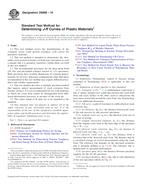Potrebujeme váš súhlas na využitie jednotlivých dát, aby sa vám okrem iného mohli ukazovať informácie týkajúce sa vašich záujmov. Súhlas udelíte kliknutím na tlačidlo „OK“.
ASTM D6068-10
Standard Test Method for Determining J-R Curves of Plastic Materials
Automaticky preložený názov:
Štandardná skúšobná metóda pre stanovenie JR kriviek plastov
NORMA vydaná dňa 1.7.2010
Informácie o norme:
Označenie normy: ASTM D6068-10
Poznámka: NEPLATNÁ
Dátum vydania normy: 1.7.2010
Kód tovaru: NS-33630
Počet strán: 8
Približná hmotnosť: 24 g (0.05 libier)
Krajina: Americká technická norma
Kategória: Technické normy ASTM
Kategórie - podobné normy:
Anotácia textu normy ASTM D6068-10 :
Keywords:
crack growth resistance, fracture toughness, J-R curves, plastics, polymers, Cracking--crack growth, Fracture testing--plastics, J-R curves, Loading tests--plastics, Plastic materials, Polymers, ICS Number Code 83.040.01 (Raw materials for rubber and plastics in general)
Doplňujúce informácie
| Significance and Use | ||||||||||||||||
|
A J-R curve produced in accordance with this test method characterizes the crack growth resistances of a wide range of tough polymers and polymer blends (1-5) that cannot be obtained in sufficient size and thickness for valid characterization by linear elastic fracture mechanics in Test Methods D5045. The J-R curve characterizes, within the limits set forth in this test method, the resistance of a polymeric material to slow stable crack growth after initiation from a preexisting sharp flaw. A J-R curve can be used as an index of material toughness for blend or alloy design, material selection, materials processing, and quality assurance (6). The J-R curves from bend specimens represent lower bound estimates of J capacity as a function of crack extension, and have been observed to be conservative relative to those obtained from specimen configurations under tensile loading. The J-R curves for a given material of constant microstructure tend to exhibit lower slope (flatter) with increasing thickness. Thus, it is recommended that the largest possible specimen with representative microstructure be used. The J-R curve can be used to assess the stability of cracks in structures in the presence of ductile tearing, with awareness of the differences that may exist between laboratory test and field conditions. A J-R curve may depend on the orientation and propagation of the crack in relation to the anisotropy of the material which may be induced by specimen fabrication methods. Because of the possibility of rate dependence of crack growth resistance, J-R curves can be determined at displacement rates other than that specified in this test method (7). |
||||||||||||||||
| 1. Scope | ||||||||||||||||
|
1.1 This test method covers the determination of the J-integral versus crack growth resistance (J-R) curves for polymeric materials. 1.2 This test method is intended to characterize the slow, stable crack growth resistance of bend-type specimens in such a manner that it is geometry insensitive within limits set forth in this test method. 1.3 The recommended specimens are the three-point bend (SE (B)) and pin-loaded compact tension (C (T)) specimens. Both specimens have in-plane dimensions of constant proportionality for all sizes. Specimen configurations other than those recommended in this test method may require different procedures and validity requirements. 1.4 This test method describes a multiple specimen method that requires optical measurement of crack extension from fracture surfaces. It is not recommended for use with materials in which the crack front cannot be distinguished from additional deformation processes in advance of the crack tip. 1.5 The values stated in SI units are to be regarded as the standard. 1.6 This standard does not purport to address all of the safety concerns, if any, associated with its use. It is the responsibility of the user of this standard to establish appropriate safety and health practices and determine the applicability of regulatory limitations prior to use. Note 1—There is no equivalent ISO standard. |
||||||||||||||||
| 2. Referenced Documents | ||||||||||||||||
|
Odporúčame:
Aktualizácia technických noriem
Chcete mať istotu, že používate len platné technické normy?
Ponúkame Vám riešenie, ktoré Vám zaistí mesačný prehľad o aktuálnosti noriem, ktoré používate.
Chcete vedieť viac informácií ? Pozrite sa na túto stránku.




 Cookies
Cookies
